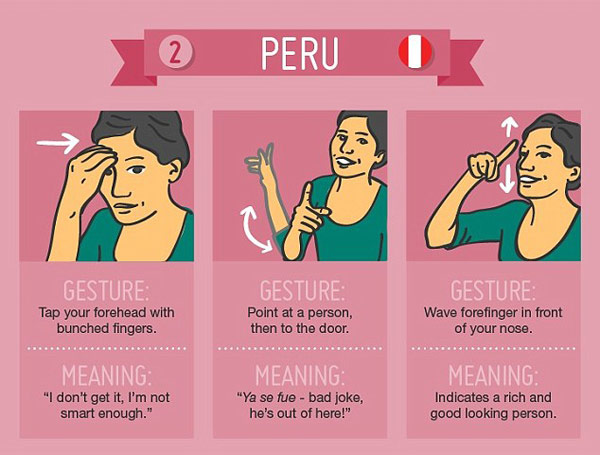
 盤點各國常見手勢 教你如何表達讚美與感謝
盤點各國常見手勢 教你如何表達讚美與感謝 
How to compliment a chef in Italy and say 'thank you' in Mexico
When words fail - and they usually do - holidaymakers resort to hand gestures to communicate with locals in a country where they don't speak the language.
每當旅客去到一個語言不通的國家遊玩又無法用言語清楚表達自我時,他們總會用手勢與當地人溝通。
But it can be a tricky endeavour as gestures that represent something innocent in one country could be offensive in another.
但即便這樣也會問題多多,因為同樣的手勢在一個國家可能沒什麼惡意,但在另一個國家可能就會帶有冒犯之意。
This helpful guide demonstrates 42 hand gestures that are common in 14 countries where visitors from abroad could run into a language barrier.
以下的指南介绍了14個國家常見的42個手勢,它可以幫助國外遊客克服語言障礙。
It said the gestures will come in handy for those who don't know the country's mother tongue or only know a few words or broken phrases but are intimidated when they communicate with locals.
對於那些不會說該國母語,或者只懂說隻言片語,和當地人說話又會怯場的人來說,這些手勢就會派上用場了。
In Italy, diners can tell their waiter or chef that their meal is 'delicious' by running their finger into their cheek.
在義大利,用餐者可以用手指在臉頰上滑動來告訴餐廳服務生或廚師飯菜非常“美味”。
In Mexico - an increasingly popular destination for Britons - visitors who are unable to speak a lick of Spanish can hold up their arm with their palm towards their face to say 'thank you'.
墨西哥現在頗受英國遊客的青睞,在這個國家,遊客要是不會說西班牙語的話,可以舉起手掌面對著自己的臉來表示“謝謝你”。
Around the world in 42 hand gestures - 來學學世界各地的42種手勢 
It's great to learn to speak a whole new language for a trip abroad, but it can take a lot of time and efforts before you can converse easily. An easy approach to understanding the locals is to know the physical cues-especially considering 93% of communication is non-verbal.
為出國旅遊而學習一門全新語言不失為一個好的想法,但是在能够熟練運用之前可能会花上大量時間與精力。考慮到93%的交流是非語言的過程,那麼要了解當地人的意思一個簡單的方法就是理解肢體上的暗示。
Brush up on your body language with this simple guide to some of the most common gestures from around the world.
以下簡單介紹一些世界上最常用的手勢,大家一起來學習一下吧。
2. Peru 秘鲁
Gesture: Tap your forehead with bunched fingers.
手勢:手指聚攏輕拍額頭。
Meaning: I don’t get it, I’m not smart enough."
意義:“我沒明白,我不够聰明。”
Gesture: Point at a person, then to the door.
手勢:指著一個人,然後指門。
Meaning: "Ya se fue-bad joke, he’s out of here!"
意義:“不好笑,出去!”
Gesture: Wave forefinger in front of your nose.
手勢:在鼻子前上下搖晃食指。
Meaning: Indicates a rich and good looking person.
意義:“暗指某人美貌又多金。”


 留言列表
留言列表
